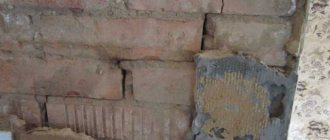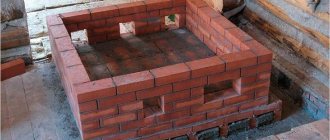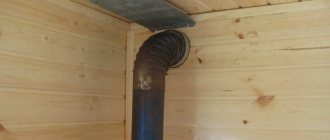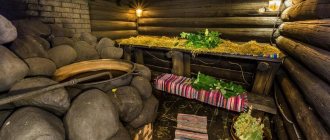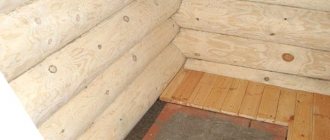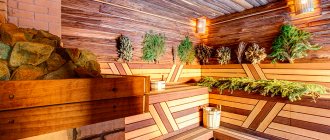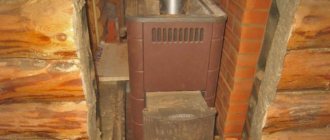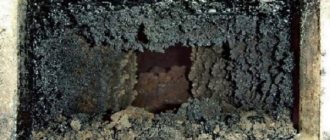After a long winter, many go to the dacha for the first time this season and, getting ready to relax, light the stove in the house or in the bathhouse. And they are very surprised when they feel carbon monoxide entering the air in the room - after all, nothing like this happened last year. After a preliminary inspection, they are convinced that smoke has penetrated through the cracks that have appeared and immediately think about how to cover up the cracks on the stove.
After calling the stove maker, it turns out that there are many problems with the structure and it requires major repairs. Without telling you how to coat the stove, he immediately issues an impressive bill, which not everyone can afford to pay. In this article we will talk about the rules for troubleshooting problems of this kind, that is, we will figure out how to cover the stove so that it does not crack.
How to cover up cracks to make it secure
To eliminate all kinds of holes that have formed during regular operation of the furnace, they try to use reliable compounds that cope with the problem the first time. In this section we will look at some of these tools.
Fireclay clay
Ready-made fireclay clay provides reliable sealing of joints that do not deform under constant exposure to high temperatures. The dried composition is characterized by a high level of vapor permeability and endurance when exposed to wet steam under high pressure.
Deep cracks on a brick wall from a home stove Source pechdoc.ru
The material is also considered environmentally friendly, since it does not emit toxic fumes when heated, and accordingly is harmless to people and animals. In order to prepare such a solution, you will need:
- one part of cement (grade “500”);
- two parts of fireclay clay (can be purchased at a special store);
- seven parts of river sand.
What causes cracks to form on the stove?
A careful visual examination allows you to detect a large number of small cracks on the stove walls, which appear due to different rates of thermal expansion of brick and masonry mortar. These cracks can be easily repaired using a stove coating mixture.
If heating occurs unevenly in different parts of the furnace, the result is rupture of the masonry joints. This problem can also be solved simply by covering the crack with a new solution.
Cracks can form as a result of improper operation, when only the folded stove begins to be fired. However, even in this case, the problem of how to cover the stove is solved with the help of masonry mortar and plaster.
If there is no heating in winter, not only the stove, but also the walls of the house crack. This happens due to temperature changes. With the arrival of the warm season, it is necessary to heat the stove, dry the walls and masonry, prepare a new mortar and cover the cracks that have formed with it (about
Video description
Plastering a brick oven with your own hands.
Special oven glue is not diluted in large quantities as it tends to harden quickly. After this, it cannot be used a second time, since repeated dilution will cause the composition to lose its strong qualities.
Using special oven glue to seal joints between brick joints in a home oven Source waysi.ru
Guide to oven coating: technology to follow
If the question arises of how to coat the stove with clay or any other means to eliminate cracks, it is recommended to follow the algorithm below. It will make it possible to do all the work efficiently the first time and without additional modifications. The process consists of the following steps:
- In the resulting gap, remove any remaining old plaster and all dust. Next, deepen this crack by 1 cm. This way you increase the repair space, which makes the sealing process more convenient. Re-dispose of all waste.
- Coat all prepared areas with water and primer, and then heat the oven so that all the liquid evaporates. Put out the fire, when all the steam has completely disappeared, it should be emanating from the surface of the oven.
- While the walls of the structure are still hot, coat the prepared areas with a clay solution. At this point, it is important not to overdo it and apply a thin layer of oven caulk.
- Afterwards, take a reinforcing mesh or burlap and secure it with small self-tapping screws to the damage so that they completely overlap.
- Next, prepare the grout solution and carefully apply two layers to the defective areas using a spatula.
Leave the structure until completely dry. Remember that lighting a fire in it immediately after caulking in order to dry the seams faster is strictly prohibited. Trying to speed up the process will result in even more cracking. At this stage, the question of how to accurately coat the outside of the stove has been resolved.
Repairing a brick kiln against cracks in the seams Source sdelai-lestnicu.ru
Selection of mixtures and solutions for furnace restoration
If you don’t have the time and opportunity to prepare a solution for filling cracks yourself, then buy ready-made mixtures in the store. There are options for fireclay masonry, grout, mastics for repair and restoration, and adhesives. On store shelves you can find brands of mixtures:
- Terracotta;
- BOSSNAB;
- Pechnik;
- SPO;
- CMEA;
- PLITONITE;
- Makarov stove house;
- Scanex.
Before using the solution, you need to carefully read the instructions on the package and make a batch depending on the proposed proportions of water and dry part.
Types of oven mixtures:
- Heat-resistant - do not expand, do not change their properties. At high temperatures it retains its structure. The composition is resistant to thermal deformation and can withstand loads.
- Heat-resistant solution - characterized by resistance to high temperatures, does not change the properties and structure, and does not deform.
- Fireproof mixture - withstands any temperature and the use of chemicals.
The basis of masonry mixtures includes cement, lime, clay, gypsum. They can also be mixed with various additives.
The components of the lime mass are quicklime and sand 1:3, the mixture is diluted with water so that the consistency resembles thick sour cream. The disadvantages of the solution include prolonged drying of the masonry and harmful fumes.
The mixture consists of sand, cement and water. Pay attention to the brand, it is preferable to buy M400-M50, M40-M500. First, mix cement with sand (1:6), then pour in liquid. If you add broken brick and Portland cement to the solution, you will get a heat-resistant mass.
How to repair a firebox in a brick stove
If the question arises of how to repair cracks in a brick stove inside, you should try to minimize the heating of the walls using additional lining. This process involves the installation of special barrier partitions that absorb the entire thermal shock. The inside of the firebox is lined with one of the following materials:
- Cast iron. This is a fairly reliable type of raw material, it is distinguished by its durability and can withstand both loads and constant high temperatures. When introducing it, be sure to leave a small air gap between it and the brick wall.
- Steel. The material will last less than the previous one, since it tends to burn out quickly. An air cushion must be created behind such a layer. To maintain it at the same distance on all sides, a corrugated layer is laid. It will burn out after the first use of the stove, and the back space will remain free.
- Fireclay brick with markings ША-6 and ШБ-6. These models are not installed tightly to the stationary walls of the furnace. The approximate gap will be 7-10 mm. The brick is laid on fireclay mortar, which has increased stickiness.
Restoration of the firebox and removal of cracks in a brick kiln Source pechdoc.ru
How to seal cracks in a metal stove
You may also need to decide how to cover the cracks in a metal stove, because it gradually burns out, and it is not always easy to allocate funds for repairs. Clay grout can be used as a restoration product. It is important to make a thick enough layer that will prevent combustion products from escaping from the firebox. The clay should be diluted in the traditional way, you can add a small amount of ash from the same oven and mix thoroughly until smooth.
Repairing a metal furnace by welding exfoliated metal fragments Source ipk-rotor.ru
If a hole or crack in the metal appears in the area where the chimney meets the stove chamber itself, then you need to take a small plate of metal, coat it with stove glue and fasten it to the deformed area. Seal the space on top with the same composition. To solve this issue, a reinforcing mesh is also used, which is subsequently plastered.
Methods of applying grout
The following methods can be distinguished for applying grout material to the seams between tiles:
Semi-dry method
When applying grout using this method, the mixture is diluted with a small amount of water. The result is a consistency that resembles wet sand. Using a special jointer, the mixture must be placed in the seam.
The advantages of this application method:
- low cost of the product;
- There are no substances among the components that provide plasticity.
Disadvantages of this grout:
- a seam that is less than 5 mm cannot be sealed;
- the color palette is limited only to gray and beige;
- the installer must have experience in sealing seams using this method, otherwise the design will be of poor quality or unaesthetic.
Using a construction gun
The grout is diluted with water and poured into a special construction tool - a gun. All seams are coated with a thin tip, and excess product is removed. To fill the joint more tightly, you can process the line by pressing the grout in with your finger or some other tool.
- simplicity and ease of application of the composition;
- You can choose the desired grout color.
- high price of the composition;
- you need a special tool;
- Among the components are plasticizers.
Applying the composition over the entire cladding area
The creamy mixture is applied over the entire surface of the tile, then cleaned off with a rubber spatula, leaving the mixture in the joints. The grout for the oven joints is removed from the tiles using a damp sponge.
- long-term operation;
- You can use any type of tile.
- high price;
- small palette of colors.
Types of cracks and features of their repair
Having figured out how to coat a brick stove when deformations appear, you need to familiarize yourself with the types of cracks that appear. Conventionally, they are divided into cobwebs and other types. The first type of cracks is classified as non-through, and therefore their treatment is much easier. To seal a sealed surface in this way, you need to follow a step-by-step algorithm:
- clean the surface and use a chisel to remove excess plaster and debris that is stuck in the cracks;
- then clean the surface nearby with a metal brush, sweep away excess dust;
- treat the prepared surface with a primer so that it penetrates into the cracks;
- mix cement with water until the consistency of liquid sour cream is formed, take a brush and treat the damaged areas with it.
Go over the cracks several times to ensure the damage is completely filled. Otherwise they will appear again very soon.
Expert opinion
It is worth cutting cracks only in a hot oven, when the brick has expanded as much as possible and gained its expansion. First you should scrape out the seams as much as possible. Most often, 2-3 centimeters will be enough. The brick above the door most likely rested on an iron corner or a strip of iron, which is why it falls out, as the metal burns through and leads it out. Or it simply hung in the air, resting only above the door. It is best to rearrange such a knot by placing bricks above the door in a “lock”, otherwise there will be no point.
It is convenient to deepen the seams using a metal bracket; its ends are sharp. Next, deepen and well-moistened using a regular flower sprayer, compact the seams on a hot stove with a small hammer and a sliver of wood with an end to the thickness of the seam. The recess that appears should be sealed with a very thick clay mortar. Usually, after such techniques, cracks no longer appear.
Video description
Oven for frying. How to put terracotta on glue.
On a note! In order not to make a mistake with the choice of grout, it is better to use ordinary clay, but first it should be checked for fat content. They do it this way: take five parts of clay and mix each of them with sand in different proportions, diluting with water. Then they make a bun from each mixture and throw it on the ground. The one that crashed is the fattest. Accordingly, the composition is ideal for sealing furnaces.
Briefly about the main thing
If cracks appear on the stove, it is important to find out how critical they are and what to do about them. Inspection of the masonry allows you to determine the cause. We can easily eliminate the defect if the cause of the cracks is infrequent or improper use, finishing errors or design flaws. Restoration will not help if a problem with the foundation or an error in the calculations is revealed.
Ready-made and home-made compounds are used for smearing. All of them, from sand-clay mixtures to ready-made adhesive compositions, are capable of qualitatively eliminating defects. To prevent cracks from appearing again, a technique has been developed for applying a plaster layer to the stove; special sealant pastes are used to restore metal surfaces.
Ratings 0
